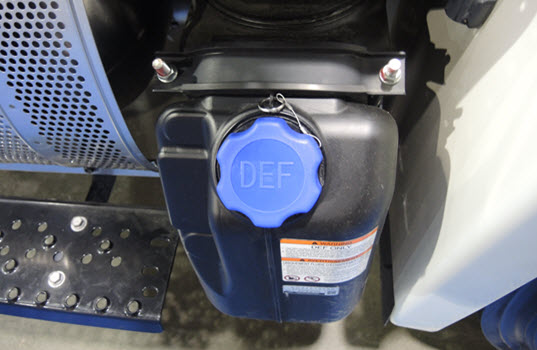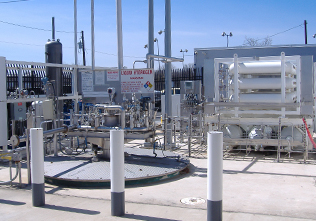PEI Revises RP on DEF Storage, Dispensing
Five Years Seems Like Ages Ago
By Rick Long
Taking lessons learned during the past five years into account, PEI’s Diesel Exhaust Fluid (DEF) Committee recently released the second edition (2015) of RP1100. The document makes technical corrections and clarifications to the original work and adds guidance on several key topics related to DEF storage and dispensing.
As was true in for the first edition, Steve Hieber of PWI Inc. in New Oxford, Pennsylvania, chaired the committee of experts who drafted the revision. Hieber expressed his gratitude for the knowledge and cooperation of all the committee members.
PEI published the first edition of RP1100: Recommended Practices for the Storage and Dispensing of Diesel Exhaust Fluid (DEF) in 2010 in response to changes in federal emission requirements for diesel vehicles and a new diesel engine technology, selective catalytic reduction (SCR).
The emission requirements lowered the allowable oxides of nitrogen from diesel vehicle exhaust. And SCR, which uses DEF for after-treatment of the vehicle’s exhaust, was emerging as the accepted solution to meet those requirements.
That first edition was intended to provide basic guidance on the new DEF storage and dispensing equipment that best would preserve the product’s quality and prevent releases into the environment.
Five years later, SCR-equipped diesel vehicles and DEF-related infrastructure are firmly established as essentials of the U.S. transportation system. Annual DEF consumption in the U.S. is expected to increase from 400 million gallons in 2015 to 1 billion gallons in 2019. And much has been learned in the process by installers, service contractors, fuel marketers and other DEF stakeholders.
Here are eight of the most important changes, clarifications and additions in this version:
- Labeling: As the DEF industry has matured during the past five years, so has the regulatory environment in which the industry operates. One regulatory development has to do with labeling requirements. Effective January 1, 2016, the National Conference on Weights and Measures (NCWM) added requirements for the labeling of DEF dispensers to its Handbook 130, the document that covers engine fuels, liquids and fueling systems. “Handbook 130 has been adopted in full by nearly 20 states, and many other states accept portions of the document,” Hieber said. “The PEI DEF Committee felt it was important for users of RP1100 to know that specific language is now required on DEF dispensers, so we amended Chapter 6 to point users to Handbook 130 for those labeling requirements.”
- Material Compatibility: To prevent contamination or an unintended release, equipment that comes into contact with DEF—including tanks, dispensers, piping and other associated components—must be compatible with the product. The 2010 version of RP1100 included examples of compatible and incompatible materials referenced in two standards: the International Organization for Standardization’s ISO 22241 and the German Institute for Standardization’s DIN 70070. The 2015 edition removed the reference to the DIN standard.
“ISO 22241 has gained wide acceptance in the industry in the last few years,” Hieber said. “DIN 70070, on the other hand, is seldom cited and has essentially become obsolete. As a result, the committee thought it would be unwise to reference both documents in the new edition. In particular, we wanted to avoid any opportunities for conflict or confusion if one of the standards changed in the future and the other did not. Given ISO 22241’s prominence, sticking to that standard was the obvious choice.”
As in the first edition, however, the reference to ISO 22241 is not meant to specify the only materials that are compatible.
“While we elected to defer to the work ISO has done in identifying compatible and incompatible materials, readers should be aware that the ISO materials lists are for guidance only,” Hieber said. “Manufacturers may test other materials for compatibility with DEF as long as the test conditions reflect the expected temperature range and contact time to give a fair assessment of any material degradation or other effects.”
- Quality: The introduction of impurities will degrade DEF and negatively affect the performance of SCR systems. The first edition of RP1100 stressed the importance of maintaining product quality throughout each phase of storage and dispensing. “For this edition, the committee decided to go even further by giving users some guidance on how to ensure that the product is still on spec,” Hieber said. “One often-used tool for doing that is a DEF refractometer, which tests the concentration of urea in the DEF, so we mentioned that approach in the new document.It’s important to mention, however, that the committee did not go as far as it could have with specific sampling and testing procedures for determining DEF specifications. The reference to refractometers simply states that the use of this device is ‘one way’ to do it.”
- Underground Storage Tanks: As DEF quantities have grown during the past few years, underground storage tanks (USTs) have become a common solution for storing the product. The 2010 edition gave early guidance on DEF USTs, noting specifically that:
- All DEF USTs should be double-walled, have secondary containment with monitoring, or both.
- The inner tank must be constructed of compatible materials.
- The inner tank and outer containment must be liquid-tight.
The new document further refined the tank requirements: “Hydrostatic monitoring systems, in which the interstitial space is filled with brine, clearly would cause contamination of the DEF if the inner wall were to leak,” Hieber said. “In the new edition, the committee pointed out this danger, in effect recommending the use of tanks with a dry interstice.”
- Overfill Protection: Sometimes one word makes all the difference. A change to section 5.2.2.6 in the revised RP1100 is an example. This section, which addresses overfill prevention, previously stated that tanks “should” be equipped with overfill protection. The new sentence states “equip” DEF USTs and ASTs with overfill protection. The committee’s deletion of the word “should” turned what had been a suggestion into a requirement. This change represents a clear decision in favor of overfill protection.
- Thread Sealant: Not every change in the revised RP1100 represents a major shift or new information. Some revisions are clarifications. One example involves the recommendations on how best to prevent DEF migration through small gaps in seemingly tight joints and fittings. The 2010 document noted correctly that installers should use a sealant on tapered threads to prevent leakage and creep. The revised document reinforces this point, adding that any sealant used on tapered threads should be compatible with DEF because sealants that are incompatible with DEF could contaminate the product, leak or creep.
- Safety: Practices designed to ensure safe workplaces and fueling facilities are at the heart of all of PEI’s recommended practices. The first edition of RP1100 mentioned safety-related considerations throughout the document. Unlike other PEI recommended practices, however, RP1100 did not include a chapter on safety. Because DEF is nontoxic, nonflammable and noncombustible, some of the safety considerations involved with petroleum handling equipment do not apply. This time, however, safety considerations received greater attention from the committee. Chapter 11 of the revised RP1100 specifically addresses the safe handling and disposal of DEF. Also mentioned in the new chapter is that excess heat or flame could increase the pressure of a closed DEF container and cause a dangerous rupture.
- Ballast: One concern that has arisen since the first edition was published has to do with ballasting DEF tanks during installation. “The committee was aware that some installation contractors have used water containing chlorine as ballast when installing DEF tanks,” Hieber said. “New language in Chapter 5 makes it clear that only DEF, distilled water or deionized water should be used as the ballasting medium. This requirement essentially ensures that there will be no risk of contaminating the DEF that is later introduced into the tank.”
Status Quo
After debate, the committee also chose not to change several decisions reflected in the 2010 edition.
- Marine DEF: In 2010, the drafting committee limited the recommended practices to motor fuel dispensing facilities, repair/maintenance garages and service centers. This excluded marine diesel environments, which use a more concentrated aqueous urea solution (AUS 40) than that used in motor vehicle fueling (AUS 32). Equipment used for the storage and dispensing of AUS 40 must be designed to meet the unique challenges of marine environments. The committee said that the installation, service and maintenance demands of marine applications were beyond their expertise and did not include recommendations for marine facilities. Similarly, no mention was made of a new marine DEF certification program soon to be launched by the American Petroleum Institute.
- Tank Installation Practices: Another area the committee did not address in depth was installation procedures for underground and aboveground DEF tanks. As in the 2010 document, the committee instead refers readers to PEI’s RP100 and RP200, the documents that cover the installation of USTs and aboveground storage tanks (ASTs), respectively.
“We decided to again rely on the expertise of the PEI committees charged with recommending installation practices, rather than cluttering RP1100 with dozens of pages on a subject we know something but not everything about,” Hieber said.
Fuelmarketnews.com






